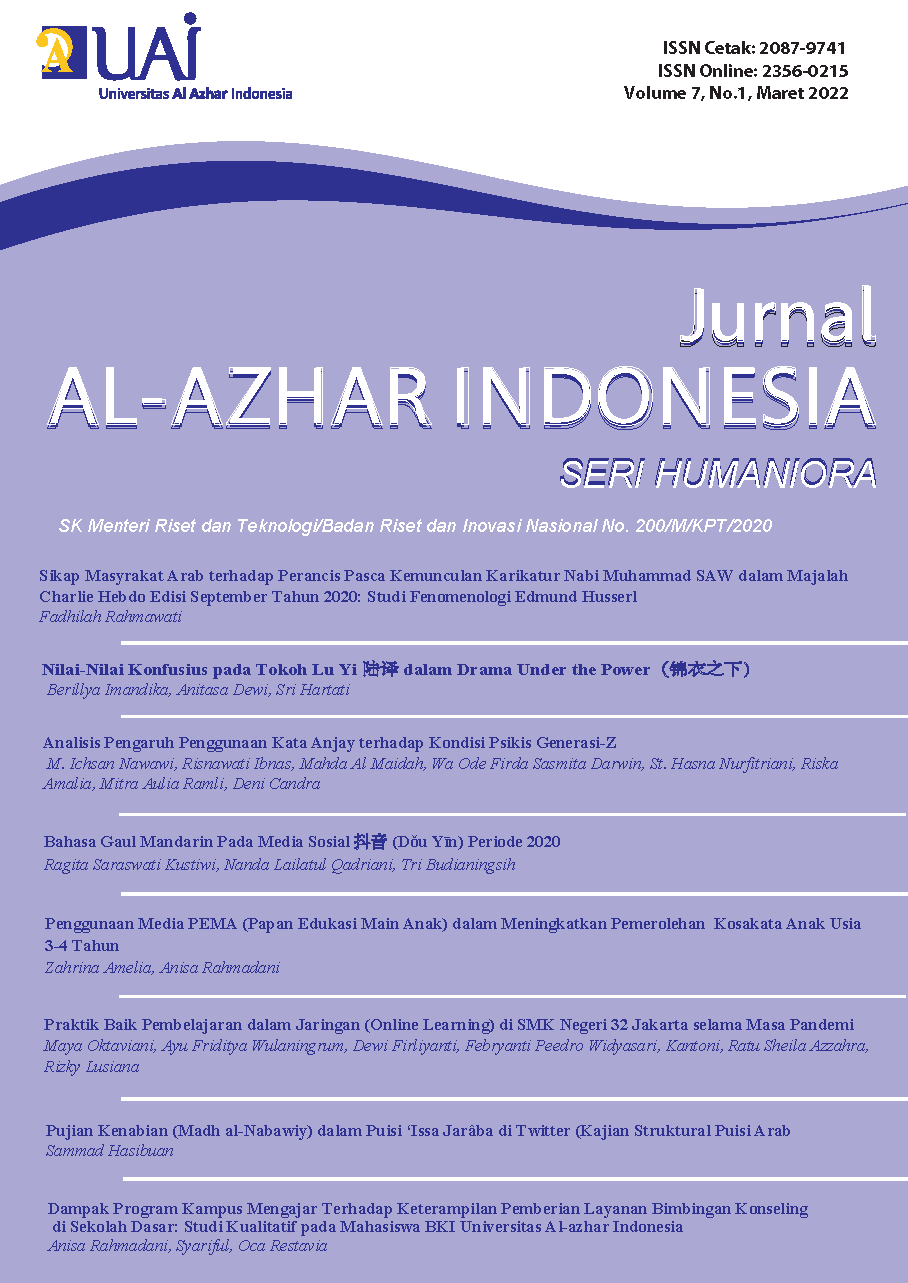Pujian Kenabian (Madh al-Nabawiy) dalam Puisi ‘Issa Jarȃba di Twitter (Kajian Struktural Puisi Arab)
DOI:
https://doi.org/10.36722/sh.v7i1.970Abstract
Abstract - In addition to using beautiful stylistic elements, the theme of praise is also an element that enhances the structure of Arabic poetry. ‘Issa Jarȃba is one of the contemporary Arab writers who is working in the Digital World. He often shares his works in the form of poetry on Twitter. One of the most interesting aspects of his poems is their theme. Therefore, this study aims to describe the themes that are often expressed in the 20 titles of poetry that he uploads through his personal Twitter account. In this study, the researcher used descriptive analytical method, while the theory used was structural theory. However, the structural element that is emphasized in this research is the theme element. The results show that the theme that is often raised by 'Issa Jarȃba in his poetry is the theme of praise to the Prophet Muhammad SAW, including praise of the superiority of the Prophet Muhammad over other prophets and praise of the perfect characteristics of the Prophet Muhammad. In addition, some of his poetry works are typographicalized by Qasdah and some are in the form of Modern poetry. The research is expected to add to the scientific treasures of cyber literature.
Keywords - Prophetic Praise; 'Issa Jarba; Twitter; Arabic poetry; CyberLiterature
References
J. Eka Sembodo, E. Budi Setiawan, and Z. Abdurahman Baizal, “Data Crawling Otomatis Pada Twitter,†in Ind. Syimposium Computing, 2016, no. 2016, pp. 11–16, doi: 10.21108/indosc.2016.111.
A. Khusniyah and E. Ardiana, “Konservasi Puisi di Era Sastra Cyber,†2016.
R. Rosalina, Auzar, and Hermandra, “Penggunaan Bahasa Slang di Media Sosial Twitter,†J. Tuah Pendidik. dan Pengajaran Bhs., vol. 2, no. 1, pp. 15–23, 2021.
Z. Sulaiman, “Peluang, Tantangan, dan Ancaman Sastra Cyber di era Masyarakat Modern,†vol. 9, no. 3, pp. 164–169, 2020.
I. N. Anitasari and R. Wati, “Perkembangan Cyber Sastra Sebagai Bentuk Resistensi Terhadap Kapitalisme,†J. LITERASI, vol. 5, no. 2, pp. 336–344, 2021.
N. A. Ridwan, “Pandangan Dunia Pengarang Dalam Tema Empat Puisi Anak Karya Sulaiman Al-Isa,†in Prosiding Konfrensi Nasional Bahasa Arab IV Malang, 2018, pp. 507–514.
A. Hidayatullah, “Tema dan Gaya Bahasa Puisi Siswa SMP: Kajian Struktural,†J. Lang. Learn. Res., vol. 1, no. 2, pp. 1–11, 2018, doi: 10.22236/jollar.v1i2.3475.
D. Suganda, M. Syasi, and Nurlinah, “Metrum dan Tema Dalam Diwan Labid Bin Rabi’ah Al-’Amiri (Kajian Ilmu ’Arudl),†Hijai - J. Arab. Lang. Lit., vol. 2, no. 2, 2019.
S. Muhammad, Ø§Ù„Ù…Ø¯ÙŠØ ÙÙŠ الشعر العربي. بيروت: دار الراتب الجامعية.
S. K. Abbas, â€œØ§Ù„Ù…Ø¯ÙŠØ ÙÙŠ شعر زهير بن أبي سلمى,†Majallat Al-Fatih, vol. 2, no. 29, 2007.
O. I. Tawfiq, “Ùنية شعر Ø§Ù„Ù…Ø¯Ø Ø§Ù„Ù†Ø¨ÙˆÙŠ ÙÙŠ الأندلس,†Majallat Jami’ah Kirkuk, vol. 1, no. 5, pp. 1–46, 2010.
’Ubadah Herz Habib, “قراءة ÙÙŠ قصيدة Ø§Ù„Ù…Ø¯Ø Ø¹Ù†Ø¯ جرير,†Majallat Kulliyat Al-Tarbiyyah al-Asasiyyat, vol. 11, no. 52, 2008.
A. Ibn Shafi, “موضوعات شعر Ø§Ù„Ù…Ø¯ÙŠØ Ø¹Ù†Ø¯ ابن التريكي,†Majallat Antropolojiyyah al-Adyan, vol. 9, no. 2, pp. 156–167, 2013.
Z. Mubarak, Ø§Ù„Ù…Ø¯Ø§Ø¦Ø Ø§Ù„Ù†Ø¨ÙˆÙŠØ© ÙÙŠ الأدب العربي. Beirut: منشورات المكتبة العصرية, 1935.
M. Yunus, â€œØ§Ù„Ù…Ø¯ÙŠØ Ø§Ù„Ù†Ø¨ÙˆÙŠ ÙÙŠ شعر Ù…Øمد بن المبروك البودوي,†Majallat Rufuf, vol. 6, no. 2, pp. 82–101, 2018.
L. Laouir, â€œØ§Ù„Ù…Ø¯ÙŠØ Ø§Ù„Ù†Ø¨ÙˆÙŠ ÙÙŠ الشعر النسائي المعاصر,†Majallat Jami’ah Al-Amir ’Abdul Qadir Li Al-’Ulum al-Islamiyyat, vol. 3, no. 34, 2021.
A. F. Effendy, “Sekilas Tentang Madah Nabawi Dalam Kesusastraan Arab,†in Prosiding Seminar Akademik, 2002, pp. 65–79.
H. H. S. Al-Zahrani, “Maṣȃdir al-Ṣȗrah Fȋ Syi’ri ‘Issa Jarȃba: Dirȃsat Tahlȋliyyah,†Majallat ’Ilmiyyat Muhmakah, vol. 1, no. 23, 2019.
H. H. S. Al-Zahrani, “Al-Simȃt al-Lafẓiyyah Fȋ Syi’ri ‘Issa Jarȃba: Dirȃsat Tahlȋliyyah,†Dhaka Univ. Arab. JournalArabic J., vol. 22, no. 20, 2019.
B. M. Al-Haj, “Min al-Bina al-Bathin Ila al-Bina al-Zahir Li al-Jumlah Al-Tarkibiyyat Fi Syi’ri ’Issa Ibn ’Ali Jaraba,†جذور, vol. 36, 2014.
Y. Yunita, “Peristiwa Isra’ Mi’raj Nabi Muhammad SAW dan Pembelajarannya,†Dewantara, vol. 11, no. 1, pp. 125–131, 2021.
F. M. Celina and N. Suprapto, “Study of Relativity Theory of Einstein: The Story of Ashabul Kahf and Isra’ Mi’raj,†Stud. Philos. Sci. Educ., vol. 1, no. 3, pp. 118–126, 2020, doi: 10.46627/sipose.v1i3.48.
A. Haris, “Tafsir Tentang Peristiwa Isra’ Mi‘Raj,†TAJDID J. Ilmu Ushuluddin, vol. 14, no. 1, pp. 167–180, 2015, doi: 10.30631/tjd.v14i1.22.
M. Misbakhudin, “Isra’ Mi’raj Sebagai Mukjizat Akal (Upaya Memahami Qs. Al-Isra’ ayat 1),†Religia, vol. 15, no. 1, 2017, doi: 10.28918/religia.v15i1.120.
H. Saputra, ““ Studi Naskah Isra ’ Mi ’ raj Nabi Muh ammad Sallalahu ’ alaihiwasallam †( Kitab Hadis tentang Isra ’ dan Mi ’ raj Nabi Muhammad SAW Karya Ulama Palembang ),†Perpustakaan IAI Agus Salim Metro, no. April, Lampung, 2020.
I. Suryaningsih and H. Hendrawanto, “Ilmu Balaghah: Tasybih dalam Manuskrip ‘Syarh FÄ« BayÄn al-MajÄz wa al-TasybÄ«h wa al-KinÄyah,’†J. Al-AZHAR Indones. SERI Hum., vol. 4, no. 1, p. 1, 2018, doi: 10.36722/sh.v4i1.245.
Y. Mastuti, “Profil Nabi Muhammad dalam Naskah Gelumpai dan Barjanzi,†Metasastra, vol. 7, no. 1, pp. 97–104, 2014.
A. S. Alim, “Visualisasi Wajah Nabi Muhammad S.A.W. dan Aqidah Islamiyah,†UNISIA, vol. 20, no. 10, pp. 29–35, 2016.
I. N. A. Zur Raffar and S. H. Hamjah, “Ciri-Ciri Personaliti Bapa Yang DiharapkanOleh Anak-Anak Dalam Keluarga,†Al-Banjari J. Ilm. Ilmu-Ilmu Keislam., vol. 18, no. 2, p. 313, 2019, doi: 10.18592/al-banjari.v18i2.2645.
S. & M. Ulfa, “Mendidik Anak Ala Rasulullah ( Propethic Parenting ) Educate Children with Rasulullah Method ( Propethic Parenting ),†J. Educ. Sci., vol. 5, no. 1, pp. 33–42, 2019.
E. Setiawan, “Nilai-Nilai Religius Dalam Syair Shalawat Burdah,†Ling. J. Ilmu Bhs. dan Sastra, vol. 10, no. 1, p. 1, 2015, doi: 10.18860/ling.v10i1.3027.




